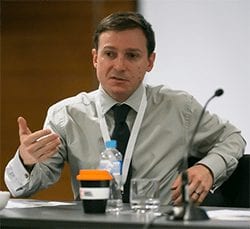The Australian Energy Market Commission’s (AEMC) has made newly announced rule changes, which are intended to ensure sufficient inertia is available as the electricity system transitions away from coal and towards renewables.
The goal is admirable as the changes ultimately aim to put mechanisms in place that support the transition. But does this work align to the bigger picture and the broader systemic view that the Finkel Review proposed?

There are many unanswered issues that are not addressed in the AEMC’s work. The Clean Energy Council recently provided two submissions to the AEMC on the proposed rule changes.
- Submission to the draft rule for managing the rate of change of power system frequency
- Submission to the draft rule for managing power system fault level
The inertia ‘problem’ is a missed opportunity
The Clean Energy Council understands the importance of carefully considering a changing power system in the transition towards renewables, energy storage and smarter demand management.
A fragmented and uncoordinated approach to the transition has led to declining inertia being the focus of one of the AEMC’s rule changes in question (more information on inertia and renewable energy can be found on our energy security page).
Reducing the size and number of large gas and coal generators certainly reduces the inertia in the system. However, there are underlying trends observed in the current power system that do not reflect the expect behaviour of a system with declining inertia.
Available evidence shows that declining inertia leads to increased rates of change of frequency (or ROCOF). Because the system is ‘lighter’ it reacts more to a fault or transmission failure (let’s call this a ‘bump’).
But, if the system reacts more to a small bump, it should only take a small bump to push it back into line. In other words a lighter system should be easier to control, not harder. As explained by leading power system engineer Bruce Miller, the system’s controls should have to work less, not more.
However, the AEMC and the Australian Energy Market Operator tell us that the system is getting harder to control, not easier. The grid frequency is getting harder to manage and is leaving the normal operating range more than ever.
Figure 1 – the frequency is leaving the normal range more than ever [2]
To illustrate the point we can contrast the difference in the control of a Mack Truck and a motorcycle. The truck’s mass makes it hard to slow down and steer, requiring lots of work and power steering to push the wheels and the truck in the right direction.
A motorcycle has low inertia. The front wheel moves the bike and rider easily with a slight twist of the handle bars. In summary, a high inertia system requires more effort than a low inertia system, for the same outcome.
In a power system, lower inertia means smaller, faster and more accurate controls could be used to manage the system frequency.
It follows that a well-designed frequency control regime should be delivering lower costs to consumers because less frequency control service is needed. This doesn’t appear to be the case in the National Electricity Market (NEM) frequency control costs have skyrocketed in just two years.
Figure 2 – frequency control costs are off the chart [3]
Something is fundamentally wrong in the NEM. Frequency control costs have risen dramatically, but the quality of the service has dived.
The issue was first highlighted earlier this year by the engineering team from Clean Energy Council members, Pacific Hydro Ltd [4].
It is now being progressed by the Australian Energy Market Operator and this work which is increasingly demonstrating that it is the controls in the NEM’s coal generators that are driving the decline in performance and subsequently the increase in cost.
More recent analysis from the Australian Energy Market Operator shows that this problem and its costs will become much worse in the coming years [5], and confirm that there is no relationship between the deployment of renewable energy and current frequency control issues across the market.
Figure 3 – No relationship between renewable energy deployment and poor frequency control
The potential opportunity of a lower-cost, higher performing frequency control regime has been lost in the AEMC’s draft rules. Lower inertia would be better managed and costs of controlling it would be lower if the frequency control regime called upon fast frequency response solutions available from demand management, energy storage and renewable energy.
The AEMC’s work on inertia has not drawn this link. It focuses on the goal of setting thresholds and standards within the current paradigm where poor power control dominates.
Putting the cart before the horse in this way means that the AEMC’s solution for transmission businesses to make investments that secure inertia will likely be excessive and overly conservative.
Old thermal coal generators are a liability to the security of the system
While older thermal generators are playing havoc with the grid frequency, the AEMC has also reaffirmed the fact that they are an unreliable source of inertia.
There is no evidence that they would remain in operation through high speed frequency changes, even those expected today. Prior to 2007 there was no standard for generators to remain in operation for high speed frequency changes. All of the NEM’s thermal coal generators, except Kogan Creek, were commissioned prior to 2007.
Unlike the advanced technologies deployed in renewables which can withstand major disturbances and frequency changes easily, there is no basis on which customers should have confidence in the performance of most of the thermal generators in the NEM. These generators may simply shut down during major power system disturbances, having a major impact on energy security. Relying on them to provide inertia to support the grid is untenable.
The AEMC’s final ruling must make it clear in the National Electricity Rules that only generators with clearly stated and known performance during power system events can provide services that support these events. Testing and certification of this capability must be a requirement to register to provide the service.
[1] https://reneweconomy.wpengine.com/inertia-power-system-dont-actually-need-much-65691/
[2] Australian Energy Market Operator, ‘FREQUENCY MONITORING – THREE YEAR HISTORICAL TRENDS’, December 2016, page 4.
[3] Australian Energy Market Operator, ‘Causer Pays Workshop 2 (presentation)’, April 2017.
[4] K. Summers, ‘Fast Frequency Service – Treating the symptom not the cause’, February 2017.
[5] Contact details can be found here https://www.aemo.com.au/Stakeholder-Consultation/Industry-forums-and-working-groups/Other-meetings/Ancillary-Services-Technical-Advisory-Group
Tom Butler is head of policy for the Clean Energy Council.











